1995 CHEVROLET CORVETTE turn signal
[x] Cancel search: turn signalPage 11 of 386
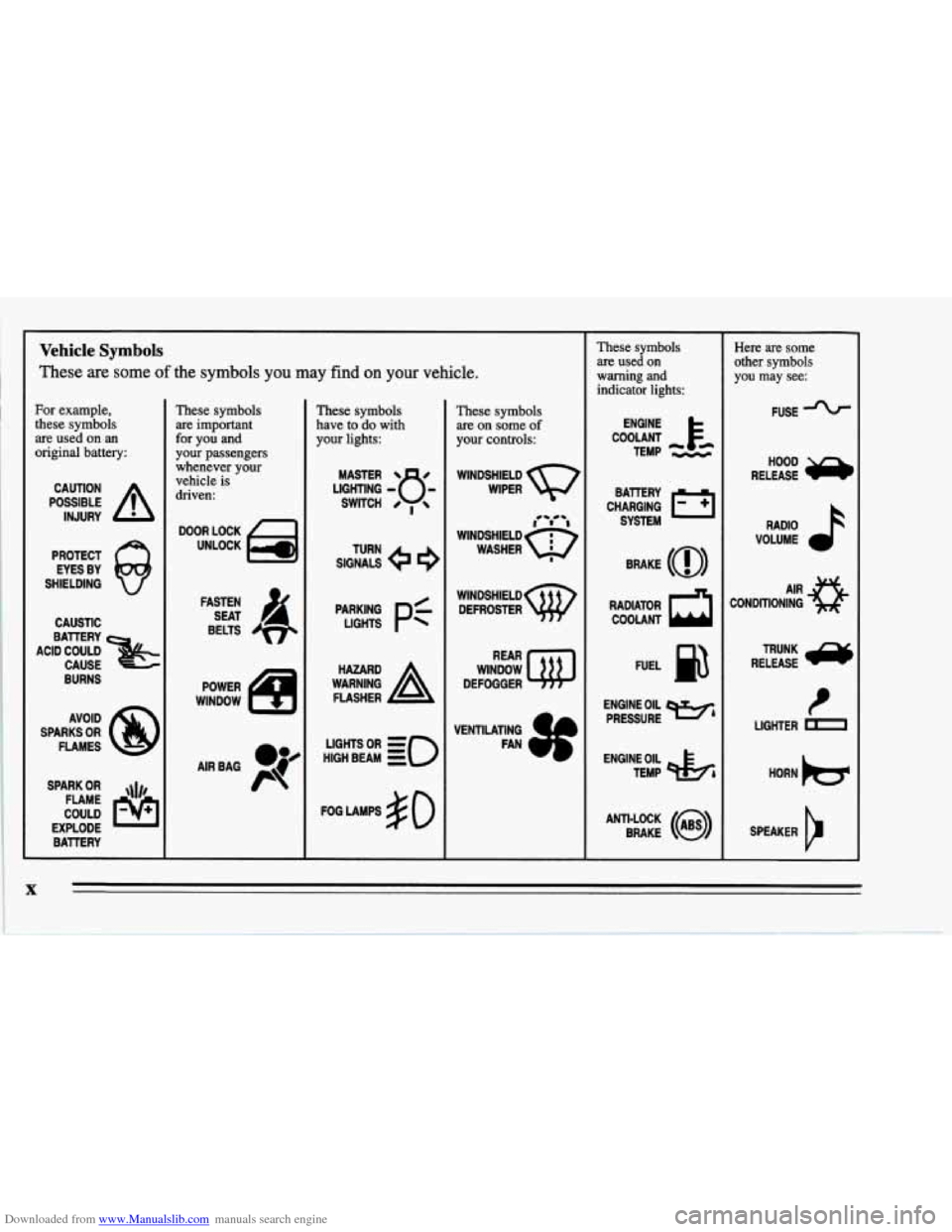
Downloaded from www.Manualslib.com manuals search engine Vehicle Symbols
These are some of the symbols you may find on your vehicle.
For example,
these symbols
are used on an
original battery:
POSSIBLE A
CAUTION
INJURY
PROTECT EYES BY
SHIELDING
Q
CAUSTIC
ACID COULD
&
BATTERY CAUSE
AVOID
SPARKS
OR
FLAMES
SPARK
OR ,\I/,
COULD FLAME
EXPLODE BATTERY
These symbols
are important
for you and
your passengers whenever your
vehicle
is
driven:
DOOR LOCK
UNLOCK
FASTEN SEAT
4
BELTS
POWER
WINDOW
AIRBAG P
These symbols
have to do with
your lights:
SIGNALS e e
TURN
p:
HIGH BEAM OR = so
FOG LAMPS # 0
These symbols
are on some
of
your controls:
WINDSHIELD
WIPER
WINDSHIELD DEFROSTER
WINDOW
DEFOGGER
VENTILATING FAN
These symbols
are used
on
warning and
indicator lights:
ENGINE
TEMP
--
CHARGING I-1
BATTERY SYSTEM
RADIATOR
COOLANT a
FUEL
ENGINE OIL PRESSURE
Wb
TEMP OtL ctlb
ANTI-LOCK (@)
BRAKE
~~ ~~~ ~ ~~
Here are some
other symbols
you may see:
FUSE -%-
RELEASE
RADIO
VOLUME
CONDITIONING
AIR 43
t
LIGHTER D
HORN )cr
SPEAKER
b
X
Page 48 of 386
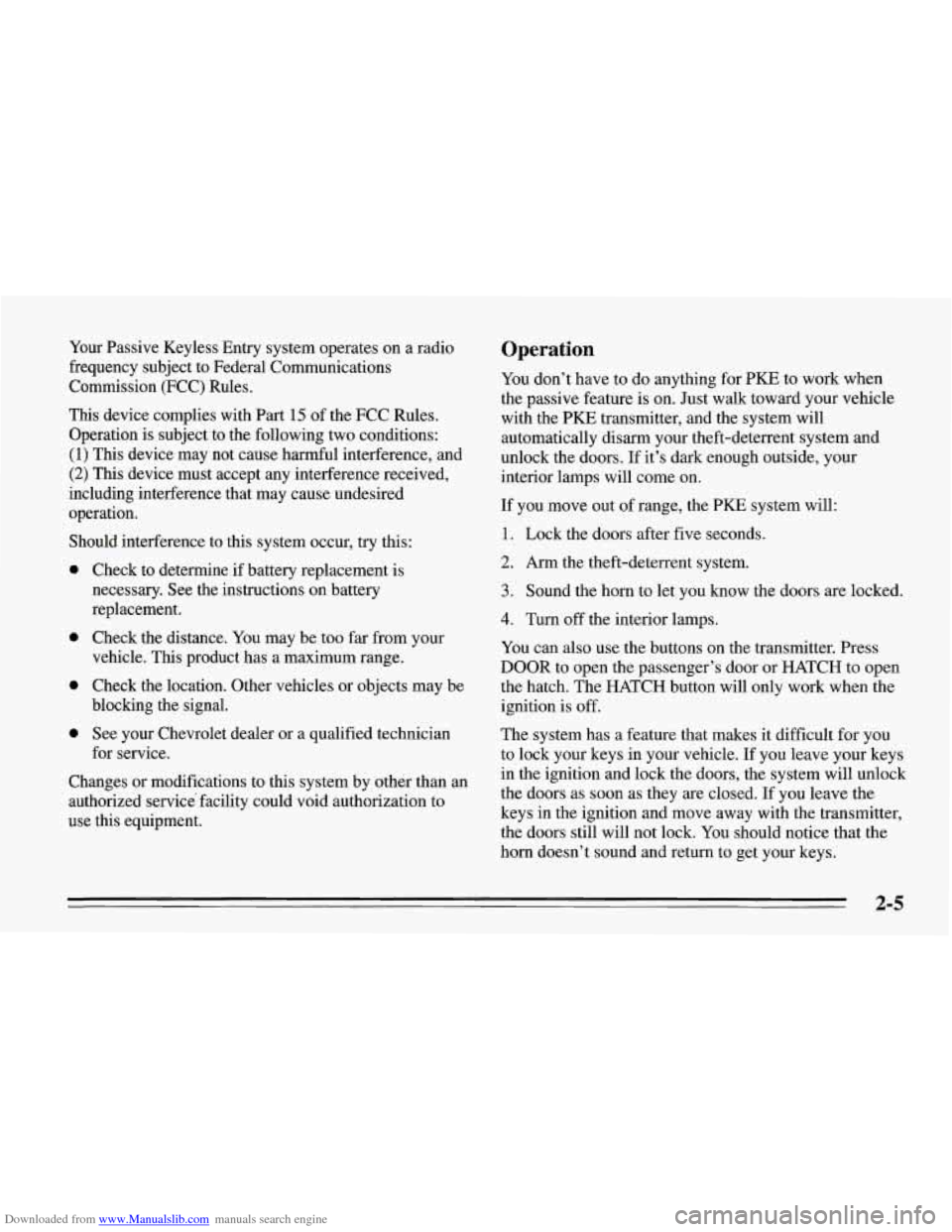
Downloaded from www.Manualslib.com manuals search engine Your Passive Keyless Entry system operates on a radio
frequency subject to Federal Communications
Commission (FCC) Rules.
This device complies with Part
15 of the FCC Rules.
Operation is subject to the following two conditions:
(1) This device may not cause harmful interference, and
(2) This device must accept any interference received,
including interference that may cause undesired
operation.
Should interference to this system occur, try this:
0
0
a
0
Check to determine if battery replacement is
necessary. See the instructions
on battery
replacement.
Check the distance. You may be too far from your
vehicle. This product has a maximum range.
Check the location. Other vehicles or objects may be
blocking the signal.
See your Chevrolet dealer or a qualified technician
for service.
Changes or modifications to this system by other than an
authorized service facility could void authorization to
use this equipment.
Operation
You don’t have to do anything for PKE to work when
the passive feature is on. Just walk toward your vehicle
with the
PKE transmitter, and the system will
automatically disarm your theft-deterrent system and
unlock the doors.
If it’s dark enough outside, your
interior lamps will come on.
If you move out of range, the PKE system will:
1. Lock the doors after five seconds.
2. Arm the theft-deterrent system.
3. Sound the horn to let you know the doors are locked.
4. Turn off the interior lamps.
You can also use the buttons on the transmitter. Press
DOOR to open the passenger’s door or HATCH to open
the hatch. The HATCH button will only work when the
ignition is off.
The system has a feature that makes it difficult for you
to lock your keys in your vehicle. If you leave your keys
in the ignition and lock the doors, the system will unlock
the doors as soon as they are closed. If you leave the
keys in the ignition and move away with the transmitter,
the doors still will not lock. You should notice that the
horn doesn’t sound and return to get your keys.
Page 49 of 386
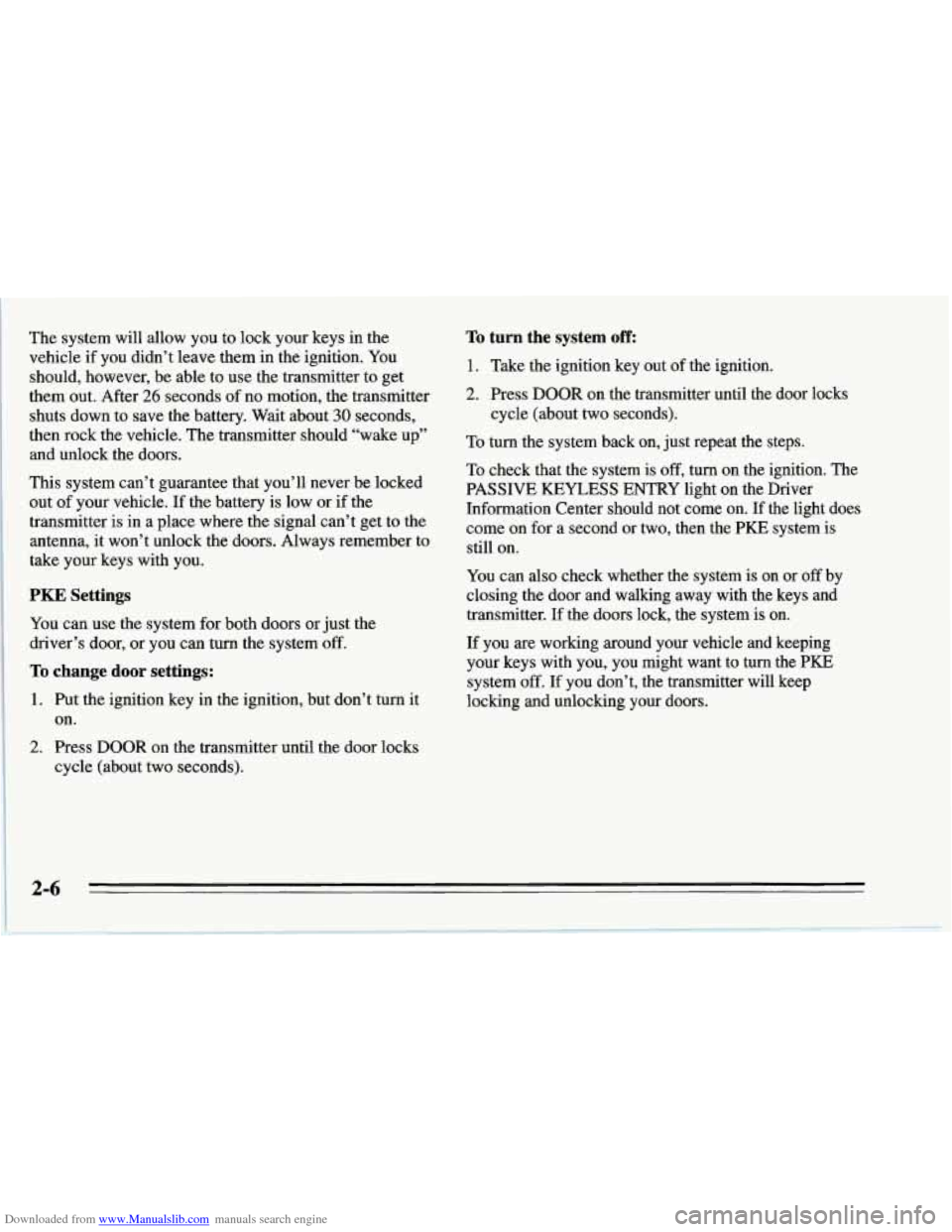
Downloaded from www.Manualslib.com manuals search engine The system will allow you to lock your keys in the
vehicle if you didn’t leave them in the ignition. You
should, however, be able to use the transmitter to get
them out. After
26 seconds of no motion, the transmitter
shuts down to save the battery. Wait about
30 seconds,
then rock the vehicle. The transmitter should “wake
up”
and unlock the doors.
This system can’t guarantee that you’ll never be locked
out of your vehicle. If the battery is low or if the
transmitter is in a place where the signal can’t get to the
antenna, it won’t unlock the doors. Always remember to
take your keys with you.
PKE Settings
You can use the system for both doors or just the
driver’s door, or you can turn the system
off.
To change door settings:
1. Put the ignition key in the ignition, but don’t turn it
2. Press DOOR on the transmitter until the door locks
on.
cycle
(about two seconds).
To turn the system off:
1. Take the ignition key out of the ignition.
2. Press DOOR on the transmitter until the door locks
cycle (about two seconds).
To turn the system back on, just repeat the steps.
To check that the system is
off, turn on the ignition. The
PASSIVE
KEYLESS ENTRY light on the Driver
Information Center should not come on. If the light does
come on for a second or two, then the PKE system is
still on.
You can also check whether the system is on or
off by
closing the door and walking away with the keys and
transmitter. If the doors lock, the system is on.
If you are working around your vehicle and keeping
your keys with you, you might want to
turn the PKE
system
off. If you don’t, the transmitter will keep
locking and unlocking your doors.
2-6
Page 82 of 386
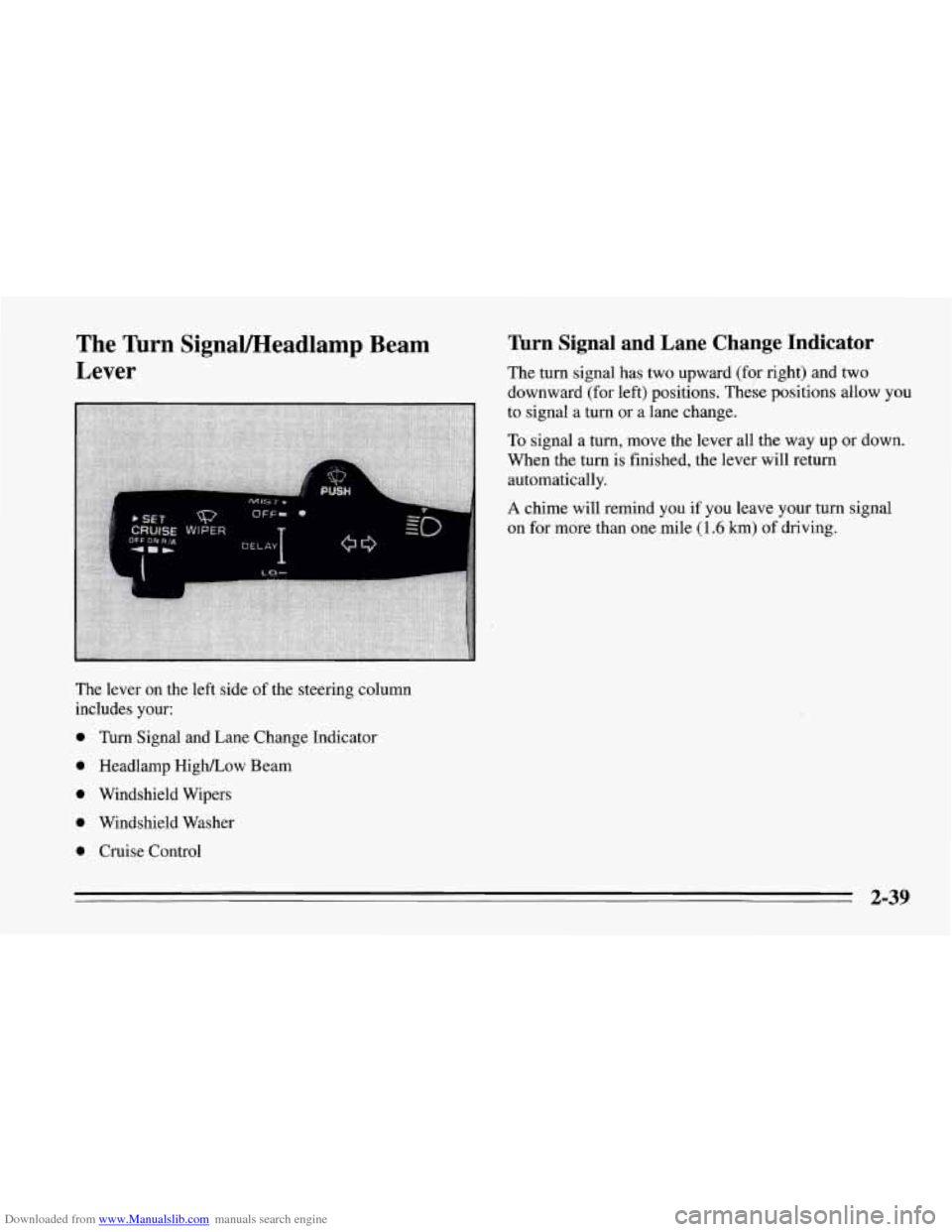
Downloaded from www.Manualslib.com manuals search engine The Turn SignaVHeadlamp Beam
Lever
The lever on the left side of the steering column
includes your:
0 Thm Signal and Lane Change Indicator
0 Headlamp HighPLow Beam
0 Windshield Wipers
0 Windsheld Washer
0 Cruise Control
Tbrn Signal and Lane Change Indicator
The turn signal has two upward (for right) and two
downward (for left) positions. These positions allow you
to signal a tum or a lane change.
To signal a turn, move the lever all the way up or down.
When the turn
is finished, the lever will return
automatically.
A chime will remind you if you leave your turn signal
on for more than one mile
(1.6 km) of driving.
2-39
Page 83 of 386
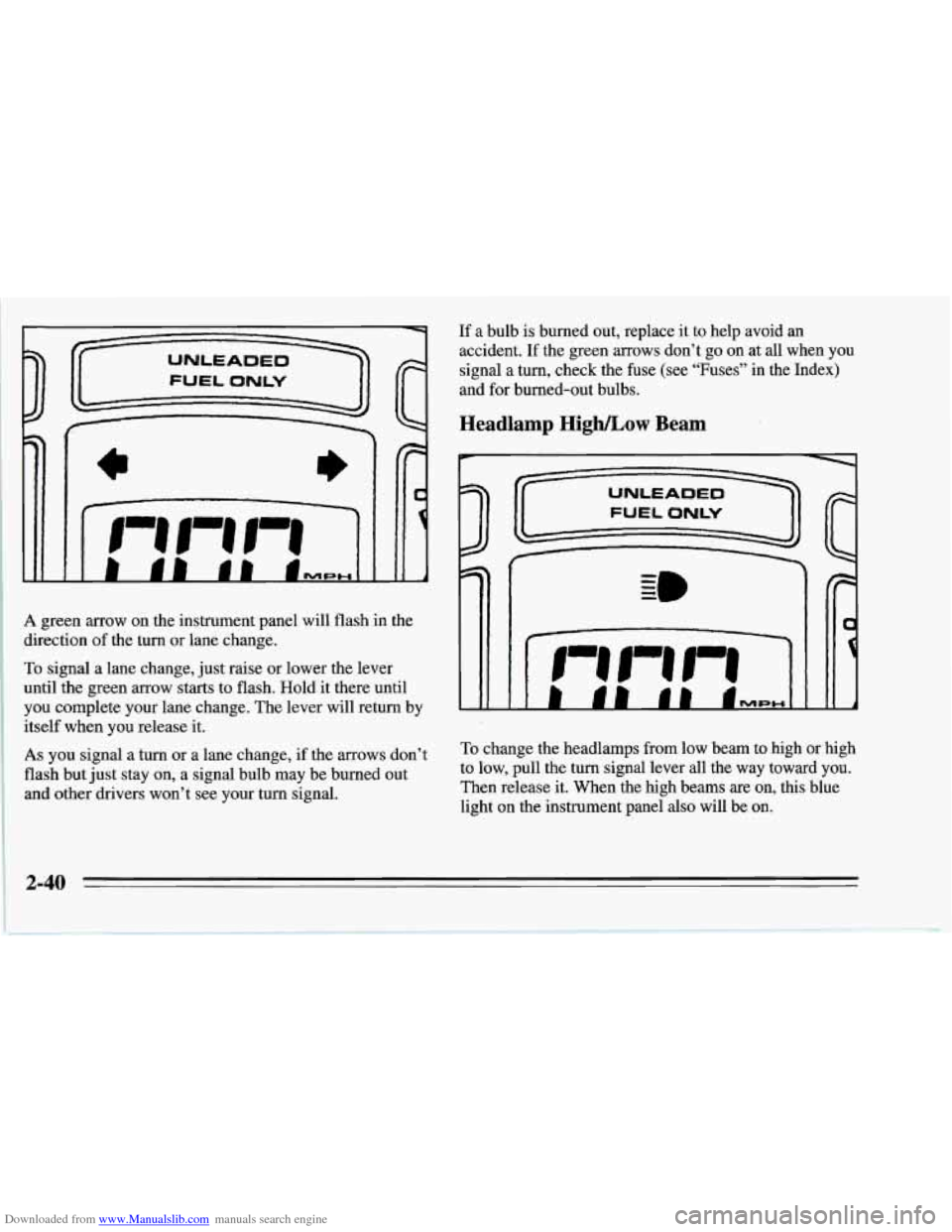
Downloaded from www.Manualslib.com manuals search engine A green arrow on the instrument panel will flash in the
direction
of the turn or lane change.
To signal a lane change, just raise or lower the lever
until the green arrow starts to flash. Hold it there until
you complete your lane change. The lever will return by
itself when you release it.
As you signal a turn or a lane change, if the arrows don’t
flash but just stay on, a signal bulb may be’burned out
and other drivers won’t see your turn signal.
If a bulb is burned out, replace it to help avoid an
accident. If the green arrows don’t go on at all when you
signal a turn, check the fuse (see “Fuses” in the Index)
and for burned-out bulbs.
Headlamp HighLow Beam
P
1 1
To change the headlamps from low beam to high or high
to low, pull the turn signal lever all the way toward you.
Then release it. When the high beams are
on, this blue
light
on the instrument panel also will be on.
2-40
Page 85 of 386

Downloaded from www.Manualslib.com manuals search engine Windshield Washer
At the top of the turn signal
lever there’s a paddle with
the word
PUSH on it. To
spray washer fluid on the
The wipers will clear the window and stop or return to
the previous setting. If you hold the paddle for more
than a second, the washer will spray until you release
the paddle.
NOTICE:
When using concentrated washer fluid,
follow the manufacturer’s instructions for
adding water.
Don’t mix water with ready-to-use washer
fluid. Water can cause the solution to freeze
and damage your washer fluid tank and
other parts of the washer system.
Also,
water doesn’t clean as well as washer fluid.
Fill your washer fluid tank only 3/4 full
when
it’s very cold. This allows for
expansion, which could damage the tank
if
it is completely full.
windshield washer. It can damage your
washer system and paint.
..
Don’t use radiator antifreeze in your
2-42
Page 90 of 386

Downloaded from www.Manualslib.com manuals search engine Headlamp Doors
The headlamp doors are designed to open when you
turn the headlamps on and close when you turn the
headlamps and parking lamps off. If you turn the
headlamps on, then turn the headlamp switch back to
the parking lamps setting, the headlamp doors will stay
open. You
can open the doors manually using the knob next to
the headlamp assembly. Turn the knob counterclockwise
until the doors are open.
The headlamp doors should be open when driving in icy
or snowy conditions to prevent the doors from freezing
closed and when washing the vehicle to help clean the
headlamps.
Daytime Running Lamps (Canada Only)
Daytime Running Lamps (DRL) can make it easier for
others to see the front of your vehicle during the day.
DRL can be helpful in many different driving
conditions, but they can be especially helpful in the
short periods after dawn and before sunset.
A light sensor on top of the instrument panel makes the
DRL work,
so be sure it isn’t covered.
The DRL system will make your front turn signal lamps
come on when:
The ignition is on,
The headlamp switch is off, and
0 The parking brake is released.
2-47
Page 91 of 386
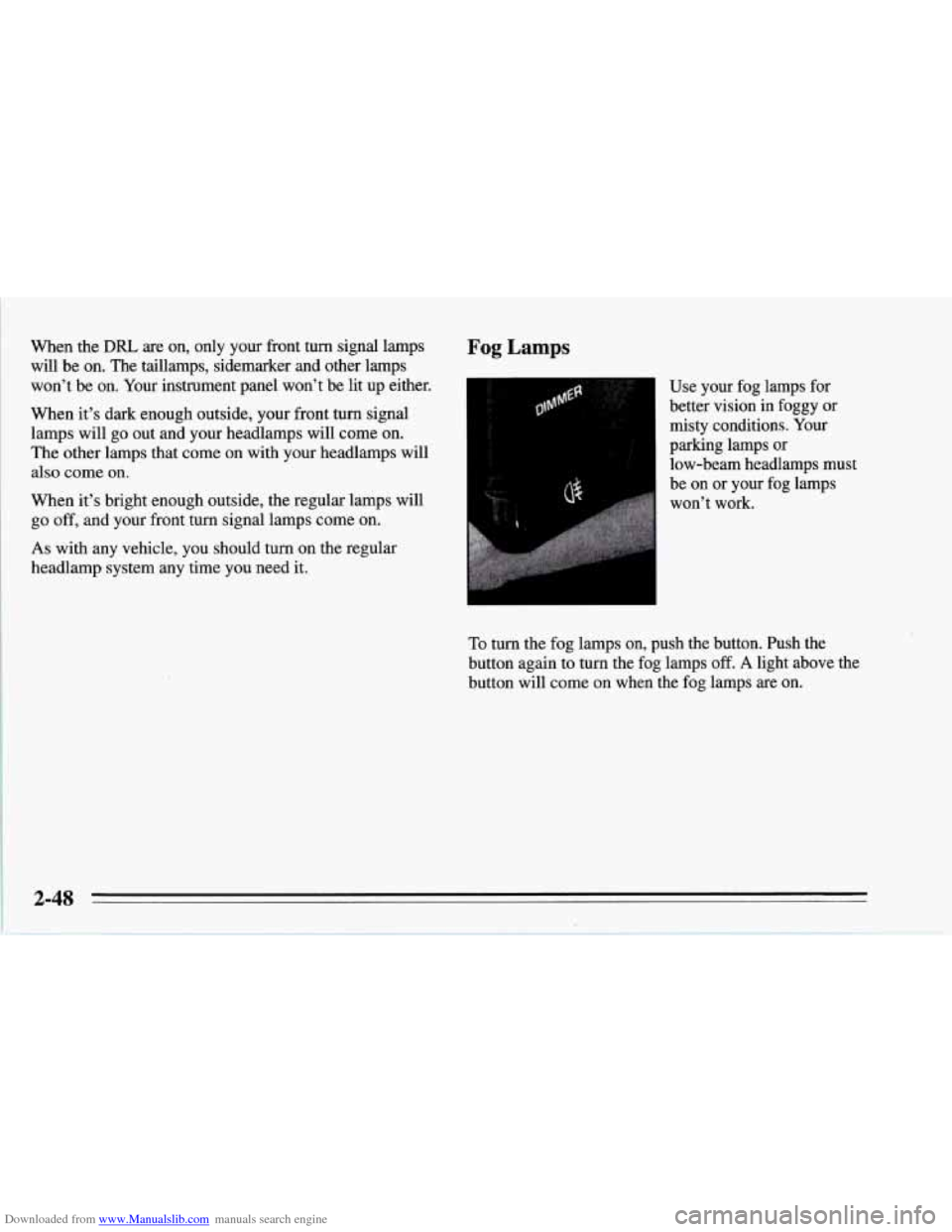
Downloaded from www.Manualslib.com manuals search engine When the DRL are on, only your front turn signal lamps
will be
on. The taillamps, sidemarker and other lamps
won’t
be on. Your instrument panel won’t be lit up either.
When it’s dark enough outside, your front turn signal
lamps will go out and your headlamps will come on.
The other lamps that come on with your headlamps will
also come on.
When it’s bright enough outside, the regular lamps will
go off, and your front turn signal lamps come on.
As with any vehicle, you should turn on the regular
headlamp system any time you need
it.
Fog Lamps
Use your fog lamps for
better vision in foggy or
misty conditions. Your
parking lamps
or
low-beam headlamps must
be on or your fog lamps
won’t work.
To turn the fog lamps on, push the button. Push the
button again
to turn the fog lamps off. A light above the
button will come on when the fog lamps are on.
2-48